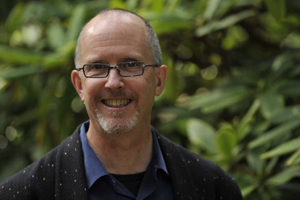So happy and so haunted: John Barton in Conversation with Stephen Marche

Malahat editor John Barton talks to issue #183, Summer 2013 contributor Stephen Marche about his new story, "How the Children Stayed Beautiful in a Time of Many Catastrophes." Stephen has set it in Ontario’s iconic, already much-“storied” cottage country.
“How the Children Stayed Beautiful in a Time of Many Catastrophes” is set in a near future where for many years the world has been traumatized and reshaped by successive waves of plague—to such an extent that, for example, North Korea has without fanfare reunified with the South, removing from the table one of our own time’s greatest perceived threats to world stability. To escape the latest wave of contagion to have reached Toronto, the story’s two single-child families decide—Swiss Family Robinson-like—to escape north to cottage country. What makes an attempt to survive a major threat to society an appealing subject for fiction?
I think the post-apocalyptic scenario is always appealing because it separates characters from their society, and tries to figure out what we are really, without all the accoutrements that we get used to. The situation that I was talking about was a series of smaller catastrophes, rather that something like a nuclear winter. Unbearable disasters that can be managed rather than the end to the world. This seems to me to be closer to the way history actually works.
Going to the cottage to avoid the heat of the city in the summer is fundamental to the lore of southern Ontario. In your descriptions of the Canadian Shield, you even evoke the memory of the Group of Seven, who also cottaged on Georgian Bay a hundred years ago. Why is cottage country such a perfect place to explore social collapse and the fallout from social anxiety? Thinking of Margaret Atwood’s Survival, is there anything particularly “Canadian” about this kind of escape?
Definitely. What is peculiar about the Canadian experience, as opposed to the American or the British experience, is that there are wildernesses in close proximity to cities. There’s no middle zone, if you know what I mean. You go from a city like Toronto, which is now bigger than Chicago, and an hour by car away you have to worry about bears. It creates an odd kind of psychological reality, a sudden geography that is jarring in its juxtapositions. The wilderness is an affront to the city and the city is an affront to the wilderness. I love it. I can’t stop writing about it.
Your story reads as both utopian—the escape into endless summer—and dystopian—social collapse in the wake of the plagues. Into this mix you introduce the idea of “drift.” Can you elaborate on what you mean by this and how it may have helped you flesh out the narrative arc of your story?
I was trying to deal with the horrifying reality that these characters never acknowledge that they much prefer living in the world where masses of people are dying. These are the happiest times of their lives. They are sort of coming to the conclusion that the planet would be so much more beautiful with fewer people in it. So what does that mean about the value of their own lives?
Both couples have also let their parenting skills drift (though, at one point, the narrator ironically suggests that because they are on an island, they are “over-parenting”). In an uncharacteristic lapse into seriousness, Dave admits that “You can only cultivate so much. They’ll [Luke and Minnow, the children] have to be like us. They’ll have to travel through the dark with us.” Are the parents seeing their children clearly? Are the children like their parents? How have their parents failed them—if they have---or what have they failed to protect them from? Are the parents, like most parents, being too hard on themselves?
I think the parents, like most parents, are just following in the wake of their children. And like a lot of contemporary parents, they feel a kind of guilt about the world that they’re leaving behind. Besides, in times of incredible change, what wisdom can you possibly have?
The waves of plague that the two families are escaping began before Minnow and Luke were born (the workers at Candlelight Burgers where they stop to use the payphone died seven years earlier; the children are both now six). Do you think any disaster of this dimension does irreversibly shape or time-stamp the character of those who grow up in one, who in their formative years know nothing else as the norm?
Children have this genius that no adult genius can really imitate for making songs and stories that help them survive. Not even the great poets and artists can really even get close. Shakespeare never wrote anything as great as “ring around a rosy, pocketful of posy, hush-a-hush-a, we all fall down.” They are capable of conjuring these whole worlds of protection. The children in the story only fitfully feel the horror encroaching. They only vaguely sense it. And yet they sense everything. They come up with an answer that their parents can’t imagine, and ultimately it’s that answer which is redemptive.
It is a great pleasure to be able to illustrate the story with the photographs you sent us. Can you shed some light on the relationship between the photos and the story itself? Where did the photos come from? Did they inspire the story or did they help shape a pre-existing narrative?
I just found them in a junk shop and knew they should go into a story about a cottage. They seem so happy and so haunted at the same time, like the people in the story.
Both in the idyllic cottage life it describes and in its title, the story is preoccupied with the intractable nature of beauty. At one point the narrator says, “During the plagues, the humanity of metaphor was more than its ordinary salve; it amounted to fleeting salvation.” Society today appears be redefining anew that Keatsian nut of “truth/beauty, beauty/truth.” Did a sense of beauty drive the narrative for you? What does beauty mean to you? Is it something to be valued in itself or for its role as a “positive” (or a “negative”) social force?
The beautiful in this story is really synonymous with the organic, whether it’s the natural world or the metaphors of the children. Unfortunately, that beauty seems completely incompatible with the adults or the world they have come from. But they are the only ones who can understand it.

John Barton
* * * * * * * *
Read "How the Children Stayed Beautiful in a Time of Many Catastrophes," by Stephen Marche here.









